
01/07/2019
Since February 22, 2019, when Algerians started to mobilize within the public space, the political scene has been taken over by weekly mass protests, described by the press as “tsunamis”, in the urban centers of the country’s large and smaller cities. Until now, the attention has been on the popular movement’s demands and successive gains, largely ignoring the spatial forms of the mobilization despite this being central to the current rebirth of civil society. Indeed, the daily fight to (re)claim public spaces has been the whole point of this uprising.
By Ghaliya N. Djelloul and Aniss M. Mezoued
By looking at this question through the lens of both sociology and urbanism, we want to analyze the spatial underpinnings of the movement and their effects on public spaces. In other words, how the appropriation of the public space has allowed citizens to open a political window and maintain it to this day, to demand a radical change in the system of governance and the establishment of the rule of law.
This uprising, which was quickly called the “Smile Revolution” for the extraordinary speeding up of time caused by the scale of the marches and the growing number of citizen-led initiatives (associative, artistic, professional, trade unions, local, etc.), allowed the expression of a peaceful political imaginary and the practice of a certain form of horizontal governance. Algerian men and women are showing a great deal of responsibility in organizing these marches, and along with their creativity, humor and collective intelligence, they are leading the way towards a peaceful and inclusive change that keeps attracting crowds of all ages, genders, classes and ethnicities.
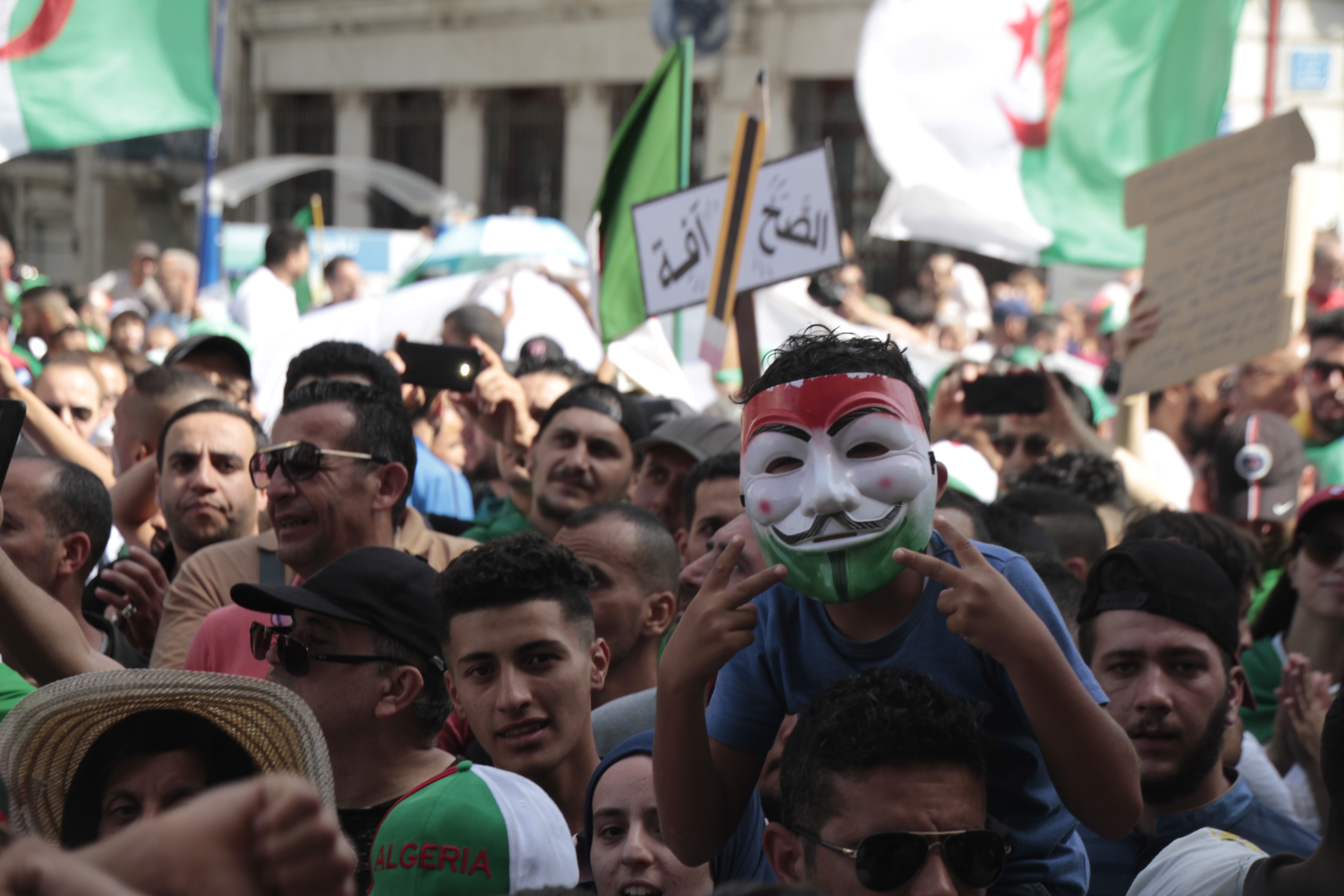
Picture 1: During the first weeks, protests were quickly brought to a standstill due to the large crowds of participants. This photo shows the importance of young people and of global references (here the Anonymous mask with the colors of the Algerian flag). © Khadidja Markemal
Thanks to their practice of an “ethos” and “pathos” of non-violence (Butler, 2017), this “smile revolution” is lowering barriers and multiplying levers to “loosen up” existing structures, allowing for the emergence of a public space. These marching men and women, recovering a sense of dignity by using their civic power, are disarming a regime that until then had engineered uncertainty in the name of stability, and are thus contributing to the (re)creation of a social order. Their mobilization allows civil society to rediscover its capacity to act and transform the course of history by recalling slogans such as: “One hero, the people.”
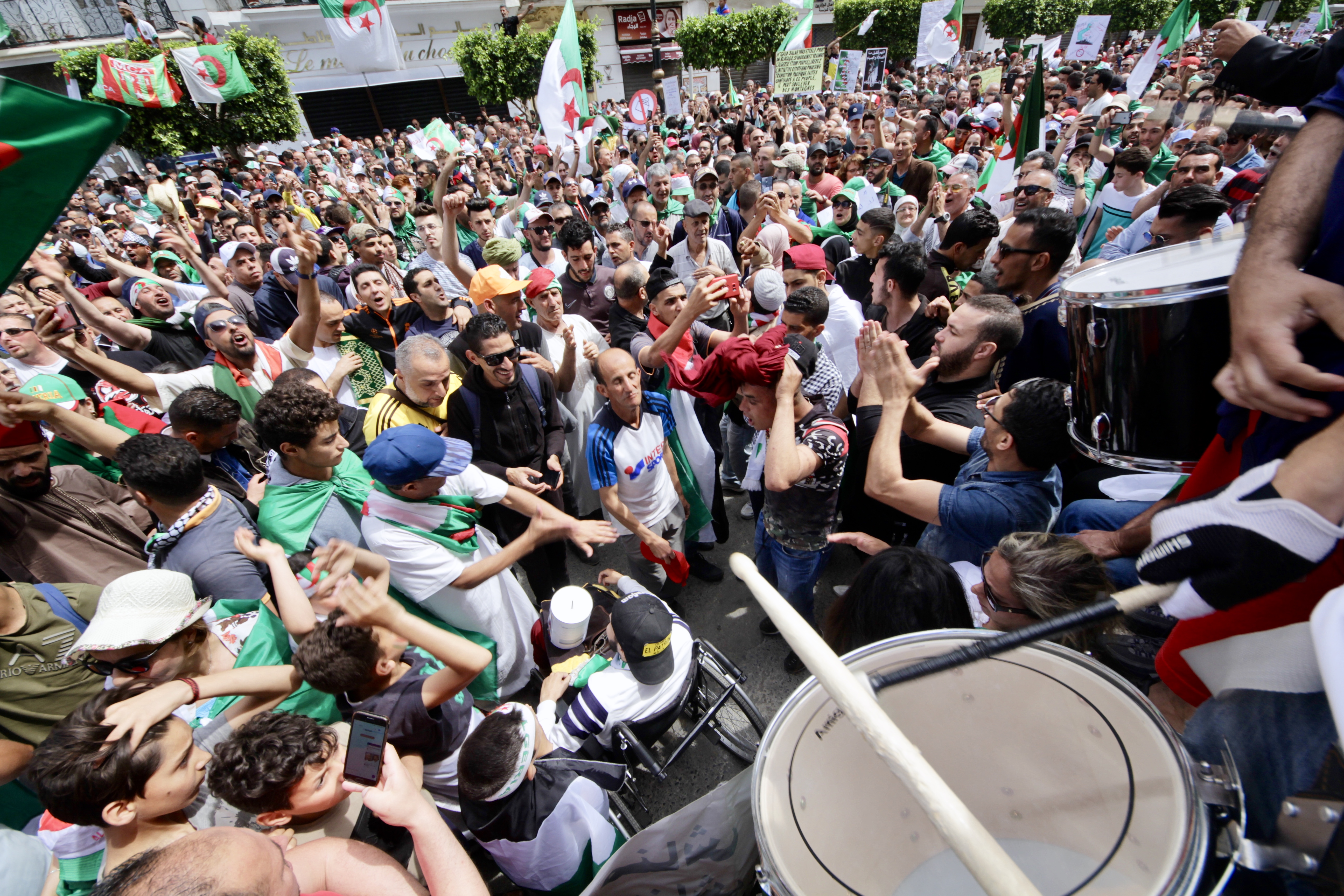
Picture 2: During the marches, protesters sing songs with lyrics that express how young people are suffering and yearning for freedom, and the beat of the drums gives the gatherings a festive and peaceful atmosphere. Among the songs are supporter chants, the national anthem and patriotic songs. © Khadidja Markemal
There had been weak signs of this social body for some years already (Mezoued, 2016), especially in the art world. But it has really emerged now, allowing people both to rediscover the idea of a public space in the political sense of a place to express and confront ideas (Habermas, 1971), and to reclaim this space in its material dimensions within the city. As the two meanings are strongly linked, our goal in this text is to take a closer look at the spatiality of events in order to highlight the other “coordinates” (Sabourin, 1997) of the mobilization: the time and language of the mass that allow for the production of a “social memory” (Halbwachs, 1938) of this collective experience. In doing so, we want to understand how this emerging (or rediscovered, or even resurrected) civil society organizes itself to maintain and sustain the mobilization through space and time.
The following expression is often used by the movement’s participants and commentators: “It is by walking that we learn to make the revolution.” Drawing inspiration from this phrase, we’ll show how the opening of the public space is a process of continuous learning, produced by practice. It is not a delineated phase or a linear movement, but rather the result of a dynamic tension of entangled space-times.
When civil society mobilizes every Friday in the urban centers of many cities throughout the country, “the people” come alive again as a collective body. This is the result of a “cognitive” and “affective” process that takes place during the week, on the internet as in the public space (Landriève, 2017). That’s why the daily management of information through the media and social networks is crucial, as it can “modulate” the representation of reality, “to structure how people become aware of specific problems and to give them a political and cultural meaning within an interactive process” (Nedelamann, 1987: 186). It also serves to create a sense of solidarity among the actors that will be “the cement of the mobilization” (Lolive, 1997: 129).
What are the conditions allowing such a movement to be set in motion (the physical ability to access, move and claim spaces) and what forms does this take? Part of the answer can be found by applying to the protesters the concept of “motility” (i.e. the ability and power to move, according to Kaufman, Jemelin, 2008), defined as the mobility potential, i.e. mobility in capacity and in action. Prior to moving, the various factors defining the usual potential for Algerian mobility are, in this case, fundamentally deconstructed and reconstructed. For instance, access to the city center, which is the gathering site, is hampered by public transport being shut down, in particular the metro, as well as by central roads being closed to cars (which is the main mode of transport in Algiers) and then reclaimed by the participants. Cars have to park on the outskirts, forcing protesters to travel long distances before reaching the gathering sites. As a result, physical and/or “resourcefulness” abilities (getting up early, carpooling, taking a taxi, spending the night with friends or family in the city center, etc.) become over-determining compared to other factors such as available transport options and location accessibility. In this regard, the award for ingenuity undoubtedly goes to a group of youngsters from the neighboring wilayah of Boumerdès who went so far as to charter a boat to bypass the roadblocks and get to Algiers! 1

Picture 3: In Algiers, public transport is shut down on Fridays. © Khadidja Markemal
As a result, a kind of appropriation and skillset for alternative mobilities gets implemented every Friday, all the while defining a new spatiality of the Algerian territory and of its mobilities. Smaller, secondary streets become the entry (and exit) points to the protest areas and serve as modal platforms that combine parking and drop-off stations for carpooling or various drivers. They also cause numerous parking problems and other nuisances (double-parking on both sides of the street, difficulties getting out, etc.). Before February 22, Fridays were steadily organized around the collective prayer, performed by the faithful in their neighborhoods, and it was only afterwards (around 2pm) that streets began filling up. Now, protesters, both men and women, are trying to reach the gathering sites as early as possible to avoid traffic jams. The collective prayer isn’t as central to how people structure their day, because of mobility strategies.
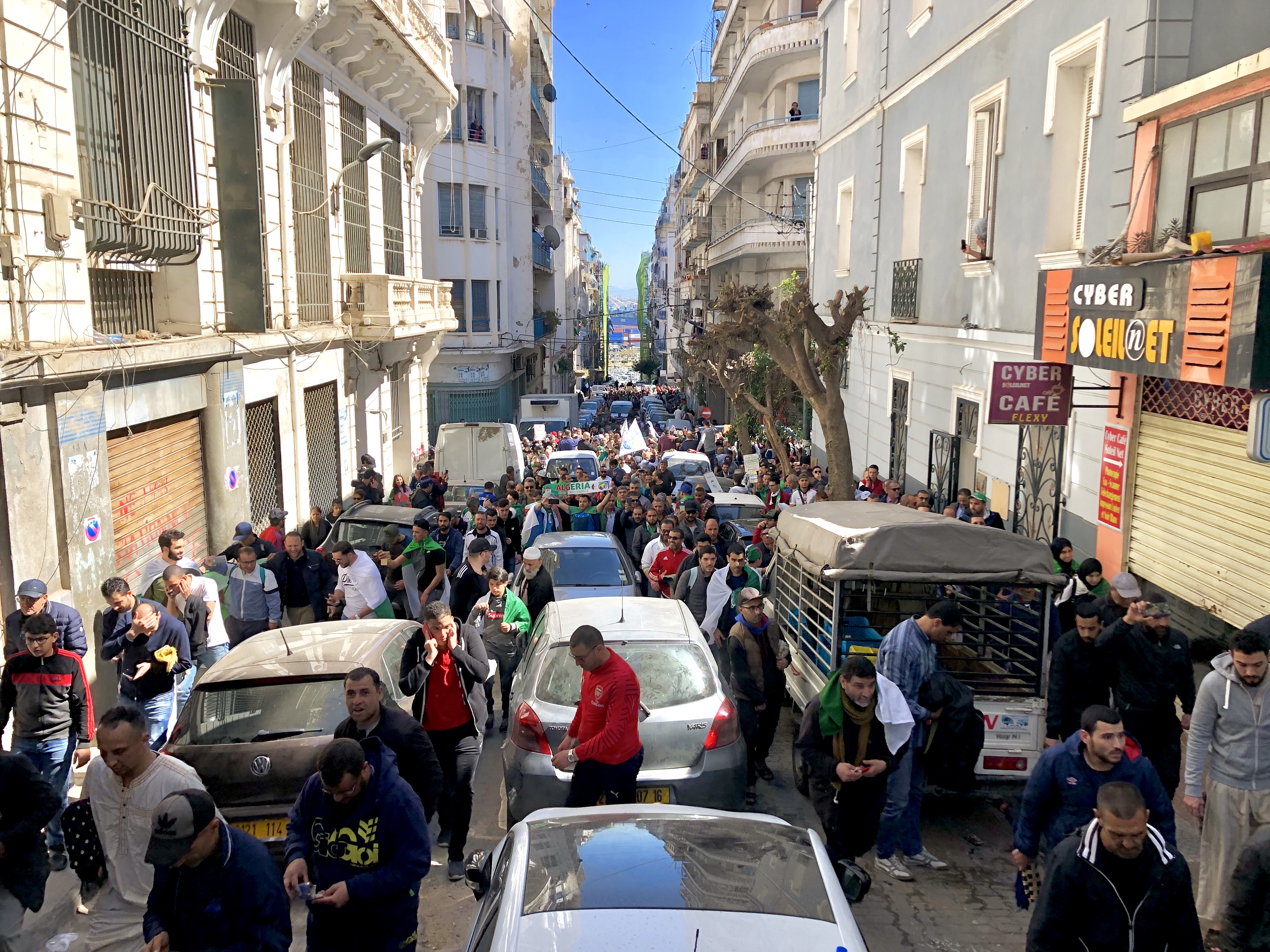
Picture 4: At some point in the day, there are so many protesters that cars can’t get around anymore. This picture was taken in one of the perpendicular streets to the main avenues of the city, where the protests are focused. © Khadidja Markemal
In the wake of the Hirak 2 of February 22, people have mobilized, and so have communication services and devices that help increase people’s mobility potential and thus facilitate their mobilization. The use of social networks and ICTs has been instrumental in helping protesters self-organize, through existing Facebook groups (Info Trafic Algeria for example) and new ones created specifically for this purpose. Similarly, on-demand mobility services such as Yassir, 3 which is gradually gaining market shares in the regular and occasional mobility of Algerians, as well as taxis, are helping people deal with public transport interruption, allowing them to reach the nearest gathering places without worrying about parking constraints.
These mobility facilitators are complemented by what we call mobilization facilitators, that act directly or indirectly on motility itself, and therefore on mobility, during protests. For instance, since the third week, teams of “green armbands” have been broadcasting information on the situation prior to each Friday protest (signaling what buildings or grounds were at risk of collapsing, giving instructions for the day's march, providing the location of medical emergency stations, etc.). On the day of the protest, they set out to spot which places are at risk of overcrowding and position themselves high up to direct crowds in the right direction, or indicate alleys through which to escape, or intervene if there is a medical emergency or any other incident. It is interesting to notice here how physical and urban skills are deployed to coordinate the collective body of the crowd, so that it does not become a source of danger for its participants.

Picture 5: A map posted on the Green Armbands’ page to inform people before the Friday march.
Another interesting initiative is the “orange vests” who appeared after clashes between police and protesters on the ninth Friday. This group established itself to intervene as mediators between these two bodies – the protesters and the police - precisely to avoid “body-to-body” confrontations.

Picture 6: Week by week, the mobilization gets organized beforehand: instructions are given to ensure the protests go smoothly and safely for everyone. © Ghaliya Djelloul
It is interesting to note how in Algiers, the urban morphology is also used to deter mobility “towards” (with roadblocks set up every Thursday morning to filter access to the wilayah of Algiers, or by surrounding protesters with a line of vans leading them to gathering places), and to force standstills “in” the spaces of the protest (with groups of police officers forming physical barriers to flank, divide and prevent progress). But the city of Algiers is also used as a resource to overcome obstacles and facilitate the popular movement’s mobilization.
As a result, the facilitators of the mobilization are constantly acting to thwart the counter-mobilization methods that have been gradually implemented since the beginning of the protests. It should also be noted that these agents aren’t necessarily union representatives or associative leaders used to organizing marches, but mere volunteers mobilized through social networks.
In order to access and navigate a city that the regime has turned into an “enclave” (Mbembe, 2016), a continuous process of emotional and physical resistance has formed both in digital and urban spaces. Both cognitive and affective dimensions are therefore core to the mobilization experience and signal the presence of conflicting temporalities.
On the one hand, the Hirak temporality imposes a weekly rhythm by stirring the collective emotions required for mobilization prior to each Friday, and then afterwards producing a political discourse to paint each march as a major political “event” that is drawing attention (Wagner-Pacifici, 2017).

Picture 7: The sound of the helicopter lurks above every Friday, like a sword of Damocles reminding “the people” of its presence. © Khadidja Markemal
On the other hand, a countermovement is trying daily to break this rhythm with dramatic events (such as arresting figures of the regime), intimidation, repression, rumors and misinformation. Protesters are thus confronted every day with an emotional tug-of-war, and it is thanks to a continuous mobilization during the week - in particular the students’ march on Tuesdays - that they can overcome the psychological pressure and prepare to face the struggles and risks of the next Friday march. It is by imagining and projecting themselves into another possible world during the space-time of the Friday protests that Algerian men and women find the cognitive and emotional resources to resist the “path dependency” (North, 1990) of a political routine that had previously discouraged them from participating in public affairs and spaces.
The occupation of the city’s public space for political protests is nothing new in Algeria. It has its roots in the mobilizations of the late 1980s, which led to the country’s early democratization (transition from a single party to a multi-party system) and the slow but gradual gain of rights and freedoms (relative freedoms of the press, of association and of assembly). However, while this early “democratic transition” had been in the works for thirty years, the Black Decade (1990-2000) that followed saw the country fall prey to insecurity and political instability, leading the government to heavily secure the sites of the State’s functioning bodies and the public space. This security apparatus had the effect of confiscating the city center and its symbolic locations (Mezoued, 2010) that had until then been the main gathering points of all mobilizations.
As a result, this security system ended up transforming urban practices, lifestyles and ways of appropriating the territory and its locations (Mezoued, 2016b). Indeed, these symbolic places (Martyrs’ Square, the steps of the government’s palace, Boulevard Zighout Youssef, etc.) have gradually become non-places (Auger, 1992), i.e. spaces that are not appropriated and not experienced by citizens, therefore detached from collective representations.

Picture 8: Police barriers block access to the city heights, in particular towards the People's Palace and the Presidency’s main offices. This picture was taken by the Telemly at the bottom of the famous “aero-habitat” housing unit. © Yacine Ketfi
Consequently, the February 22 protest gradually reinvented symbolic places through moments of standstill, occupying spaces during the marches. As a result, the staircase of the Post Office (Grand Poste), the faculty tunnel, Maurice Audin square and the under-construction building of La Parisienne became the new symbolic places of protest, constituting both physical and political public spaces. Protesters tried to reach other areas, including the El Mouradia Palace which is the site of the presidency’s main offices in the city's heights, but marchers were blocked in as far away as possible, in other words as low down as possible given the city’s topography.
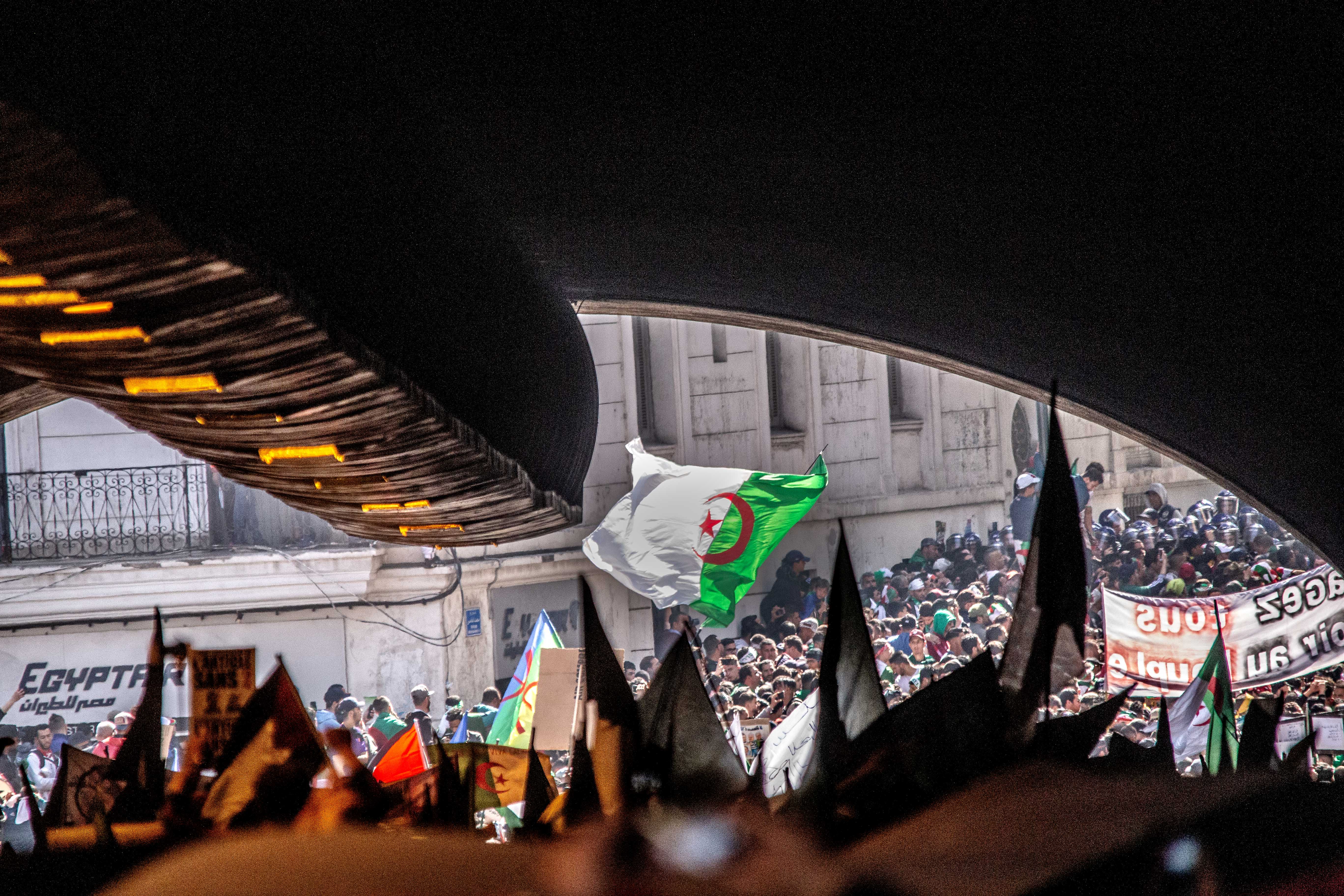
Picture 9: The Faculty Tunnel was a highly symbolic place, with intense gatherings because of its confinement and the noise saturation caused by the echo. It leads to the Audin square and protest area at the beginning of Boulevard Mohammed V, and then further on towards the Telemly and aero-habitat (previous picture). © Yacine Ketfi
These new symbolic places are therefore targeted by new confiscations designed to undermine the mobilization. The faculty tunnel, for instance, has been completely barricaded by police vans since the ninth Friday, while the steps of the Post Office have been surrounded by metal fences, under the pretense of construction work, since the thirteenth Friday.

Picture 10: The confiscation of one of the most symbolic locations of the protest: the Post Office. The staircase was barricaded under the pretense of refurbishing work on the stairs, then blocked off by police vans. © Sofiane Bakouri
In other respects, the relationship between mobility and immobility helps define specific modalities of how public space is appropriated. This is particularly the case of the “feminist square” that was established at the end of the fifth week at the central faculty’s entrance. Leveraging the opening of the public space, this place of expression has attracted a lot of criticism, accused of “separatism” and attempting to disturb the movement’s unity: why indeed isolate themselves in a square instead of participating in the collective march? And why this desire to raise awareness about women’s specific demands? These accusations allowed many to justify violence against feminists.
However, a group called “Algerian women for a change to equality” (Femmes algériennes pour un changement vers l’égalité) claims that creating this square was a deliberate strategy to allow women to “gather and walk together,” 4 to overcome the difficulties they have in meeting (due to specific constraints and obstacles to their mobility practices) all the while remaining “inside” the movement - not outside - given that after one hour, their square sets itself in motion. This way of appropriating the public space underlines their desire, as a minority group, to “form a political body” before joining the march, so as to politicize women’s condition behind a common barrier and slogans.

Picture 11: Week after week, the feminist square provides a platform for younger generations of feminists, reminding the world of the role that women have always played in Algerian social struggles. © Leila Saadna
What made the Hirak of February 22 so special was its pacific nature, established from the onset with the slogan Silmiya which means “peaceful,” “non-violent.” The various agents of the mobilization capitalized on this and continuously strive to maintain this non-violent character, despite attempts to ignite protests and clash with police – and while some trouble has occurred, it remains marginal given the overwhelmingly peaceful movement throughout the country. Despite the many ideological differences that emerge as the mobilization spreads over time, especially regarding the outcome of the revolution and what forms the political transition could take, the call for Silmiya during the protests and the occupation of public space remains the most consensual element. It is reflected in humorous and self-deprecating ways, drawing on Algerian and international cultural references (TV shows, films, music, etc.) to deconstruct the representations of political violence and keep expanding the “realm of the possible” (Badis, 2019).
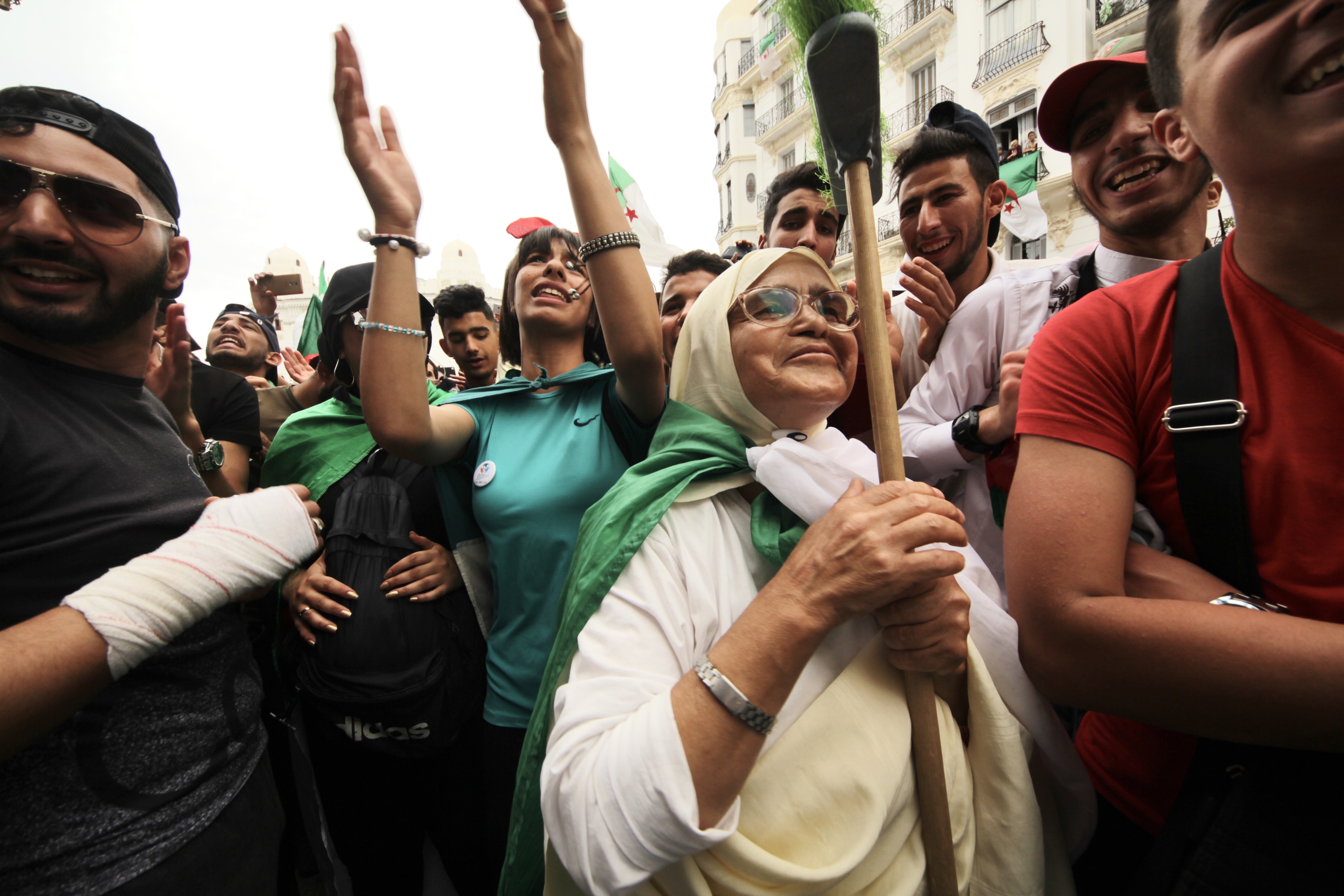
Picture 12: Brooms are one of the symbols used to represent, with humor, the need to clean up the Algerian political class. © Khadidja Markemal
Non-violence is therefore the rule that protesters impose on themselves to allow divergent ideas to coexist in the public space. The slogans “Yetne7aw ga3! Yet7asbou ga3! Netrabaw ga3!” 5 (They must all go! They must all be judged! We must all learn!) truly express this desire to break with the past, but also to evolve towards a new kind of harmonious cohabitation, where non-violence, which now seemingly serves as a form of “collective therapy” (Carlier, 1995), would finally guarantee the existence of a civil fabric.
Finally, what better way is there to conclude this text about the ongoing revolution than with a slogan from the movement itself: “Walking is good for your health. Protesting is good for your dignity!”
Augé, Marc. 1992. On-Places: An Introduction to Supermodernity . Verso Editions.
Badis, Salah, 2019. « Extension du domaine du possible ». HuffPost Maghreb , 25.02.19. https://www.huffpostmaghreb.com/entry/extension-du-domaine-du-possible_mg_5c73cf3ee4b06cf6bb28632c?utm_hp_ref=mg-algerie
Butler, Judith. 2017. Interprétation de la non-violence . In: Botbol-Baum, Mylène (éd.), Judith Butler, du genre à la non-violence. Nantes : Cécile Defaut, p. 84-98.
Carlier, Omar. 1995. Entre nation et jihad: Histoire sociale des radicalismes algériens . Paris : Presses de la Fondation nationale des sciences politiques.
Djelloul, Ghaliya. 2019. « Algérie : quand la société civile renaît ». The Conversation France, 27.02.19. https://theconversation.com/algerie-quand-la-societe-civile-renait-112638
Habermas, Jürgen. 1997. Théorie de l’agir communicationnel . Paris : Fayard.
Halbwachs, Maurice. 1970. Morphologie sociale (1938). Paris : Armand Colin.
Kaufmann, Vincent et C. Jemelin. 2004. « La motilité, une forme de capital permettant d’éviter les irréversibilités socio-spatiales ? », Espaces et sociétés .
Landriève, Sylvie. 2017. « Mobilisation », Forum Vies Mobiles. https://fr.forumviesmobiles.org/reperes/mobilisation-3609
Lolive, Jacques. 1997. « La montée en généralité pour sortir du Nimby. La mobilisation associative contre le TGV Méditerranée », Politix , vol. 10, no 39, p. 109-130.
Mbembe, Achille. 2016. Politiques de l’inimitié . Paris : La Découverte.
Mezoued, Aniss. 2010. Alger : du centre « confisqué » à l’éclatement des centralités . Notes de Recherche, EDT-Développement territorial.
Mezoued, Aniss. 2016a. « Espace (s) public (s) d’Alger : les signaux faibles d’une reconstruction spatiale et d’une construction politique », Les cahiers raisonnance , p. 49-55.
Mezoued, Aniss. 2016 b. « Terrorisme, d’Alger à Bruxelles », La Libre Belgique .
Nedelmann, Birgitta. 1987. « Individuals and Parties-Changes in Processes of Political Mobilization », European Sociological Review , vol. 3, no 3, p. 181-202.
North D. 1990. Institutions, Institutional Change and Economic Performance . Cambridge : Cambridge University Press.
Paul Sabourin, « Perspective sur la mémoire sociale de Maurice Halbwachs », Sociologie et sociétés , vol XXIX, no 2, automne 1997, p. 139-161. Montréal : PUM.
Wagner-Pacifici, Robin, 2017, What is an Event . Chicago : Chicago University press.
1 https://www.huffpostmaghreb.com/entry/interdits-dacces-a-la-capitale-pour-manifester-ils-decident-dy-venir-par-barque_mg_5cc422dae4b04eb7ff9637f3 (consulté en juin 2019).]
2 Literally means “movement.” This term was quickly used for the mass uprising that began on February 22, inspired by similar mobilizations throughout the region. In Algeria, it’s most usually pronounced “Harak.” For more information, see: https://www.elwatan.com/edition/actualite/du-hirak-au-harak-tentative-de-lexique-17-05-2019 (accessed in June 2019).
3 Algerian equivalent of Uber. There are now several such companies, the main ones being: Yassir, Temtem, Coursa, Wassalny and Amir.
4 During a conference on “Violence Against Women: Let's Talk About It!”, on May 29, several members of the collective spoke out on the subject. See: https://www.facebook.com/lejounalducrisfeministealgerien/videos/2403810172973825 (accessed in June 2019).
5 The numbers 3 and 7 replace the letters ع and ح, officially transcribed as ' and h. These are common conventions, and here we are faithful to the spelling used on the signs.
Movement is the crossing of space by people, objects, capital, ideas and other information. It is either oriented, and therefore occurs between an origin and one or more destinations, or it is more akin to the idea of simply wandering, with no real origin or destination.
En savoir plus xMobilization is the action by which individuals are called upon to gather in the public space for a concerted effort, be it to express or defend a common cause or to participate in an event. In this respect, it is a social phenomenon appertaining to mobility. This article has been written by Sylvie Landriève, Dominic Villeneuve, Vincent Kaufmann and Christophe Gay.
En savoir plus xFor the Mobile Lives Forum, mobility is understood as the process of how individuals travel across distances in order to deploy through time and space the activities that make up their lifestyles. These travel practices are embedded in socio-technical systems, produced by transport and communication industries and techniques, and by normative discourses on these practices, with considerable social, environmental and spatial impacts.
En savoir plus xLifestyles
Other publications